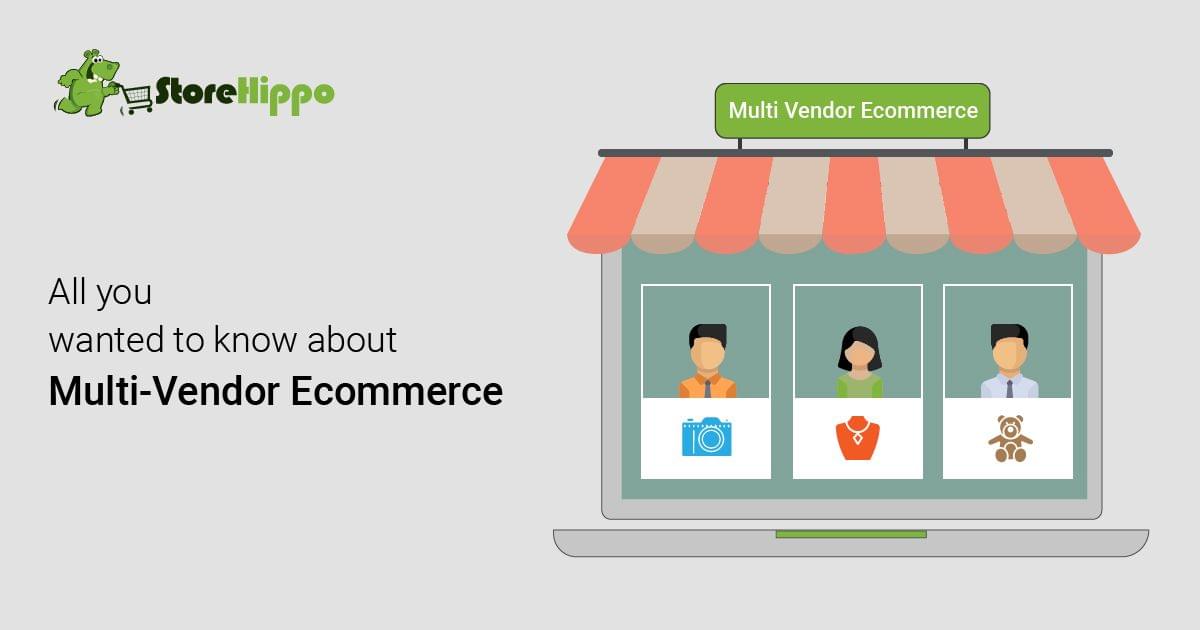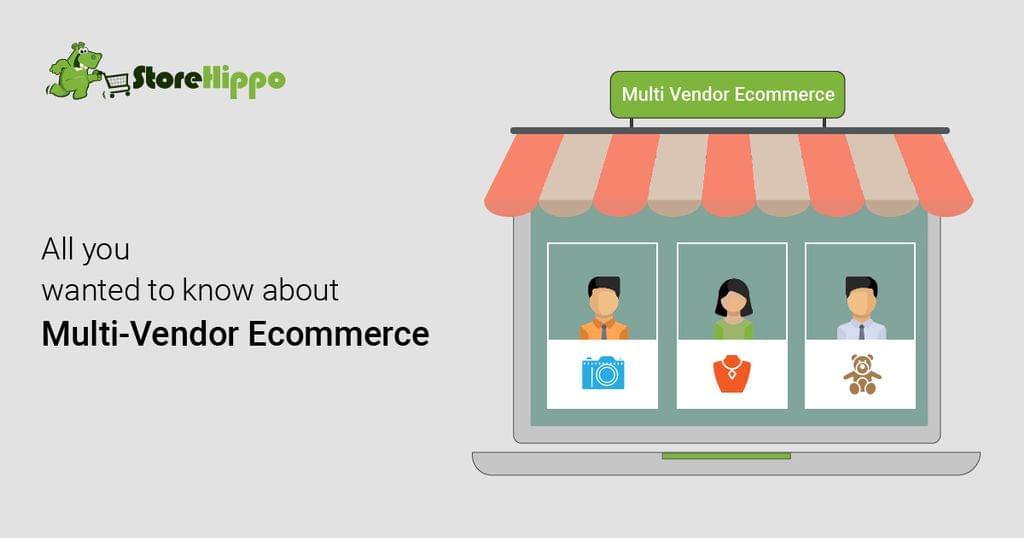They say that all great ideas strike at the oddest hours of the day. So maybe you were in the bathroom or the kitchen doing the dishes when the idea of starting a multi-vendor marketplace hit you. Well, first of all, congratulations! Because starting your marketplace is an ideal thing to do in today’s digitally-dependent times.
Did you know that customers spent $1.8 trillion globally on Online marketplaces in 2018? Think about 2020 and see the staggering figures in your head! Moreover, the marketplace accounts for more than 50% of global online sales.
Why? In comparison to a simple e-commerce store, customers get a variety of goods or services under one roof. With different vendors listed on the same multi-vendor marketplace, buyers can also avail of a good price and decent deals, all from the comfort of their homes!
Now even though it sounds so much simpler, it doesn’t mean that you can just take off and launch your multi-selling model. From understanding the business setup to finding the right kind of Online solution, there are a lot of things to consider. And we are sure you might also be having several questions bogging your mind about partnerships, commissions, types of marketplaces and its benefits.
In this article, we have tried to cover most of the important things that can throw light on a multi-seller marketplace model. So let’s get going and help you clear the fog.
Table of Contents
- Multi seller marketplace FAQs
- 1. What is multi-vendor e-commerce?
- 2. How is a Multi seller marketplace different from regular e-commerce?
- 3. How does a multi-seller marketplace work?Image
- 4. What are the different types of online marketplaces?
- 5. What are the top multi-seller platforms to seek inspiration from?
- 6. What are the benefits of your multi vendor e-commerce?
- 7. What are the must-have features for your online marketplace?
- 8. How can you market your multi vendor e-commerce business?
- 9. What is the best way to build a multi-seller marketplace?
- 10. Why is StoreHippo the best solution to build your multi seller marketplace?
Multi seller marketplace FAQs
1. What is multi-vendor e-commerce?
A Multi-seller marketplace is a one-of-its-kind e-commerce business with a win-win situation for all the parties involved. This includes the owner, the vendors listed on the marketplace and the customers who visit the market to buy the products.
Under this setup, the owner has a platform where several vendors are invited to sell their products online. Since there are multiple sellers listed on the market place, customers get to explore a wide range of products at one go. The owner of the multi-vendor e-commerce enjoys a commission per vendor sale. The vendors, in turn, get to host their products with minimal investment and leverage the brand value of the marketplace to attract buyers and boost sales.
2. How is a Multi seller marketplace different from regular e-commerce?
A multi-selling marketplace set up and a regular web store are two very different things. They have separate features, practices and business prospects.
Let’s look at some of the most common differences between the two.

Multi-vendor marketplace | E-commerce store |
Owner invites multiple vendors on the platform to sell products or services | An online store only has one seller (i.e. you as a business owner) |
A widely popular model because of product range, increased traffic, a greater number of shoppers and more sales. | Takes time to scale up because of limited inventory and segmented audience. |
High-quality vendor listings generate trust amongst customers | Customer trust has to be earned from scratch. |
Processes such as order flow, inventory management, payments, logistics, etc. are part of the vendor responsibility. | The owner has to take complete charge of orders, uploads, inventory, shipping, return logistics and more. |
Have various sales models like fixed sales, auction or mixed sales. | Regular e-commerce mostly works on fixed sales. |
3. How does a multi-seller marketplace work?Image
The owner of the marketplace is the admin who builds the platform and invites multiple sellers. This Ecommerce system comprises the admin, the sellers and the customers. Vendors are also considered as the stakeholders in a multi-vendor marketplace.
Generally, vendor listings on a marketplace are free of cost. You may also charge a small fee for the listing to filter vendor options and cut the competition. Once the vendor products are listed on the platform, customers can start purchasing products online.
After the fulfilment of product delivery by the vendor, the admin initiates the payment process to the vendor and keeps the commission fee as part of the multi vendor e-commerce revenue.
While all these processes sound a little overwhelming, it’s surprisingly simple when managed through a Turnkey e-commerce platform.
4. What are the different types of online marketplaces?
Vertical Marketplace
In a vertical marketplace, the demand stems exclusively from a specific industry or a niche market. Think of a company selling medical lab equipment. It will have no market outside of the Medical industry, right? This is an example of a niche, vertical marketplace where the admin of the platform will have to advertise its business on medical websites, doctors’ online forums, etc. This way the ads would reach their target audience.
You can start by creating a niche multi-vendor marketplace that only focuses on selling products under one category. Like for example sports goods, makeup wear, toys or any one particular vertical. This will help you cater to a specific audience segment and have their undivided attention. Thus, with a single product line, you can create a strong brand value and build your business.
Horizontal Marketplace
Another option is to create a horizontal B2B or B2C marketplace to sell multiple product lines. Your multi vendor e-commerce could list products or services from a variety of business verticals, offered by different sellers. This is one of the most popular forms of marketplaces and attracts a wide range of audiences. It also helps you generate more sales in a stipulated time, given the variety of products sold.
It's not very difficult to guess a giant who excels under this category. Amazon, of course, comes top on the list for a well-crafted horizontal marketplace. It sells books, clothes, gadgets, grocery, home accessories and almost everything.
To begin with, your horizontal multi-vendor marketplace could be small with a limited number of categories. Since you can always extend this model at any point in time, you can keep adding further categories and vendors as and when you are ready to manage more.
Service Aggregation Marketplace
What else? Well, you can always kickstart a service aggregation marketplace and invite various vendors to list their services on your platform. This is a network model that puts several unorganized service providers (of one category) under one roof. This way, the vendors can sell their services by leveraging the multi vendor marketplace brand name.
The most common examples include cab aggregators and bus aggregators like Uber or redBus. You can also think about the most in-trend Service aggregator model in the footsteps of Swiggy and launch your brand to invite multiple vendors.
5. What are the top multi-seller platforms to seek inspiration from?
Envy is not a strategy. Therefore, we would recommend you to look at other successful business models to build up your Marketplace.
To answer your question, Flipkart, Amazon, Snapdeal, etc. are some of the popular marketplaces. But you can always explore more and check out some less popular yet amazingly managed multi vendor marketplaces across different segments. Studying their strategies, vendor listings, styles and businesses will help you set up your model very easily.
For instance, Footloos is a marketplace that’s all about travel activity. From a Theme-based adventure to a handcrafted holiday into the woods, one can find all types of sellers for holiday needs.
Likewise, Artisan Born is another niche marketplace. It is all about craftsmanship and connecting customers with sellers to fulfill their personalized furniture requirements.
6. What are the benefits of your multi vendor e-commerce?
Aha! As an admin, that’s your primary interest because you can have a fringe benefit! Here’s why.
- This model offers a vast range of choices to your customers and hence creates more traffic
- High-quality vendors make more sales which means more revenue for you
- You get to do away with the burden of managing Logistics, Inventory, Product inflow, etc.
- You are at a lower capital risk as vendor commissions covers the costs
- You can scale your business at any point in time
7. What are the must-have features for your online marketplace?
Effective management of multi vendor e-commerce requires some non-negotiable features. This helps you roll out smooth business and satisfy your vendors and customers. What you need is:
- A flexible backend and front end to manage vendors and customers easily
- Supportive vendor management for product uploads, Inventory management and shipping distribution
- Good search and filter options for customers to shop by brand, category, price range, etc.
- Easy accounting processes to manage commission, shipping charges and vendor ledgers.
- Multilingual feature for a B2B or B2C business model that can be extended to go global
- A Mobile-first solution that allows you to tap omnichannel sales
8. How can you market your multi vendor e-commerce business?
As an owner, driving traffic to the marketplace is your responsibility. You need to ensure that your business achieves success and sustainable scalability through effective Marketing strategies. You can either collaborate with the vendors and run discount offers, promote deals and announce free shipping to attract customers. Or opt for marketing campaigns on social to divert traffic to your marketplace.
If you think that initially, this may not be possible, you can always try strategies that do not cost much and yet manage to market your business. You can:
- Strengthen existing user-relationships through personalised messaging and freebies to attract them to your multi vendor e-commerce
- Drive meaningful engagement that is user-generated such as a selfie contest, testimonials, etc.
- Try, inbound marketing tactics like storytelling, coaching or educating your audience
- Find influencers for your niche and promote them to drive traffic
- Network on popular online forums
- Transmit your business values through social
It’s also a good idea to sneak peek what other multi vendor marketplaces are doing to promote products online. Some entrepreneurs use a strong SEO strategy whereas others strengthen their storefront by carefully dividing the overall marketplace into various tabs. When each page delivers a good viewing and browsing experience, it’s easier for customers to look for vendors and products of their choice.
9. What is the best way to build a multi-seller marketplace?
If you are planning to launch a marketplace you can either go for;
- a custom made set up or
- use an existing platform
Customized versions generally turn out to be expensive and eat up most of your time that you can otherwise invest to grow your multi vendor e-commerce. With the turnkey solution make sure it offers you flexibility and scalability to tweak the platform as per your need.
Hence, it is always better to rely on an established e-commerce platform offering multi-seller functionality. This way you can skip the hassles of building a Marketplace from scratch and save on your resources.
10. Why is StoreHippo the best solution to build your multi seller marketplace?
The future of multi-vendor e-commerce is bright. To stay ahead in the game, you need a future-ready solution such as StoreHippo. This simple, hassle-free platform helps you launch your marketplace and quickly scale it to earn good revenue.
With StoreHippo, you can:
- Handle vendor registrations, approvals and management of unwanted product uploads
- Create a transparent flow of processes by individual vendor dashboards and product management system
- Scrutinize day-to-day business details like sales, revenue, vendor performance, footfalls, etc for better business management
- Set up flexible vendor commissions depending upon their performance, product categories, etc.
- Keep vendors and customers informed about upcoming promotions on your multi vendor marketplace using SMS, email, browser and mobile push notifications
- Provide vendors with the flexibility to manage their inventory, shipping, orders and render technical support for better performance
- Get a comprehensive vendor ledger for tracking payments, receivables, etc for vendors
- Avail adaptive payment to automatically split vendor share and admin commission from the payment gateway
Now that all your questions are answered, you must be all set to make your marketplace announcement, public. With the power of a fully-featured e-commerce platform, what have you got to lose?
You can create a beautiful and functional marketplace. You can attract vendors across different verticals and drive killer traffic to your marketplace. Do we even have to tell you that happy and satisfied vendors and customers will give you nothing but deep pockets!
Have some more questions? Bring it on! We are just a call away. Or drop us a line below.





















Leave A Comment